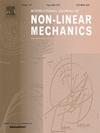Instability analysis of Li-ion battery electrode particles induced by chemomechanical growth using incremental deformation theory
IF 2.8
3区 工程技术
Q2 MECHANICS
International Journal of Non-Linear Mechanics
Pub Date : 2024-10-19
DOI:10.1016/j.ijnonlinmec.2024.104926
引用次数: 0
Abstract
Volumetric swelling due to lithiation into active battery materials is a well-known phenomenon. A chemo-mechanical framework can suitably explain the deformations of the electrode and the generation of diffusion-induced stresses (DIS). Various experimental works have shown that the effects of DIS further cause the active material to lose its structural stability. However, relatively few frameworks exist that can investigate such phenomena in a comprehensive manner. These are mainly based on the Euler–Bernoulli beam theory and the von-Karman plate theory. In the present work we present a generalized three-dimensional instability framework incorporating the theory of incremental deformation. We use this theory on a widely used chemo-mechanical framework. Notably, similar existing instability investigations on negative electrode materials are based only on incompressible material behaviour. As opposed to it, in this work we have considered a compressible material. Also, we account for the spatial and temporal nature of growth, which is a significant departure from the existing instability frameworks. Therefore, this current work brings the investigation of structural instability of electrode material closer to physical reality. In our study, we use the compound matrix method to find the critical lithiation parameter. Then we consider three sets of problems, each with a particular combination of boundary conditions applied on the inner and outer cylindrical surfaces of hollow cylindrical anode particles. These are free-free, fixed-free, and free-fixed, where each combination represents a particular type of interaction between an electrode particle and its surroundings. Most importantly, we find that the free-free and fixed-free conditions show only a pure axial and mixed mode of instability, and do not show the pure circumferential mode. The free-fixed conditions, however, shows all three modes of instability. Additionally, the presence of mode crossover makes the instability pattern of such electrode particles significant.
利用增量变形理论分析化学机械生长诱导的锂离子电池电极颗粒的不稳定性
活性电池材料的锂化导致体积膨胀是一种众所周知的现象。化学机械框架可以很好地解释电极的变形和扩散诱导应力(DIS)的产生。各种实验工作表明,扩散应力的影响会进一步导致活性材料失去结构稳定性。然而,能够全面研究此类现象的框架相对较少。这些框架主要基于欧拉-伯努利梁理论和冯-卡门板理论。在本研究中,我们提出了一个包含增量变形理论的广义三维不稳定性框架。我们将这一理论用于广泛使用的化学机械框架。值得注意的是,现有关于负极材料的类似不稳定性研究仅基于不可压缩的材料行为。与此相反,我们在这项工作中考虑了可压缩材料。此外,我们还考虑了生长的空间和时间性质,这与现有的不稳定性框架有很大不同。因此,目前的工作使电极材料结构不稳定性的研究更接近物理现实。在我们的研究中,我们使用复合矩阵法来寻找临界锂化参数。然后,我们考虑了三组问题,每组问题都有特定的边界条件组合,应用于空心圆柱形阳极颗粒的内外圆柱表面。它们分别是自由-自由、固定-自由和自由-固定,其中每种组合都代表了电极粒子与其周围环境之间的一种特定类型的相互作用。最重要的是,我们发现自由无固定条件和自由固定条件只显示纯轴向和混合不稳定模式,而不显示纯圆周模式。而自由固定条件则显示出所有三种不稳定模式。此外,模式交叉的存在使这种电极颗粒的不稳定模式变得非常重要。
本文章由计算机程序翻译,如有差异,请以英文原文为准。
求助全文
约1分钟内获得全文
求助全文
来源期刊
CiteScore
5.50
自引率
9.40%
发文量
192
审稿时长
67 days
期刊介绍:
The International Journal of Non-Linear Mechanics provides a specific medium for dissemination of high-quality research results in the various areas of theoretical, applied, and experimental mechanics of solids, fluids, structures, and systems where the phenomena are inherently non-linear.
The journal brings together original results in non-linear problems in elasticity, plasticity, dynamics, vibrations, wave-propagation, rheology, fluid-structure interaction systems, stability, biomechanics, micro- and nano-structures, materials, metamaterials, and in other diverse areas.
Papers may be analytical, computational or experimental in nature. Treatments of non-linear differential equations wherein solutions and properties of solutions are emphasized but physical aspects are not adequately relevant, will not be considered for possible publication. Both deterministic and stochastic approaches are fostered. Contributions pertaining to both established and emerging fields are encouraged.

 求助内容:
求助内容: 应助结果提醒方式:
应助结果提醒方式:


